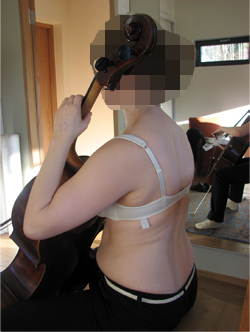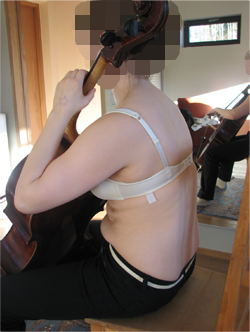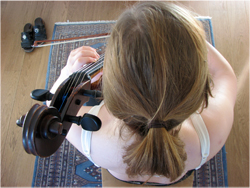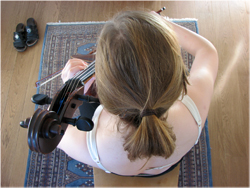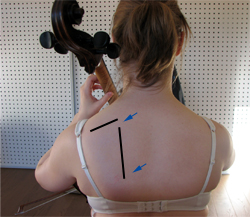Cello - harjoittelu
Cello
Läs först avsnittet Allmänt om ergonomi.
Cellistens bäcken och ryggrad ska vara i mittställning men ändå möjliggöra fri rörelse under spelandet. Rörelsen börjar och slutar i mittställning. Mittställningen är alltså musikerns grundställning, till vilken musikern alltid återkommer. I mittställningen upprätthålls ryggradens naturliga bågform. Ryggradens böjning är individuell, så i mittställning har alla olika ställning på ryggrad och bäcken.
Bäckenet är i mittställning då bäckenets sittben är placerade rakt nedåt mot stolen. Att upprätthålla bäckenets mittställning kan vara svårare när man sitter på en alltför låg stol. Justering av sitthöjden är det första cellisten bör fästa uppmärksamhet vid. Stolens höjd bör vara sådan att fötterna är stadigt på golvet, bäckenet hålls i mittställning (utan större ansträngning) och ryggmusklerna är aktiva men inte alltför spända. Sitthöjden är alltid individuell eftersom det finns skillnader i bäckentraktens smidighet. Vissa kan sitta på en låg stol utan större muskelarbete, medan andra, på grund av styvare bäckentrakt, måste sitta på en högre stol.
|
Bäcken och ryggrad är i mittställning, skulderbladen är platta, väl stödda mot bröstkorgen. |
Bäckenet lutas bakåt och hela ryggraden rundas, huvudet skjuts framåt, skulderbladen lutas framåt med bröstkorgen då skulderbladets stöd försämras. |
Instrumentets stackel ställs in så att bäckenets och ryggradens mittställning kan bevaras. Om instrumentet ställs in för lågt böjer sig ofta ryggen. Cellistens ryggrad vrids lätt åt vänster. Denna vridning förstärks av stråkens rörelse till A-strängen samt vänster hands rörelse till greppbrädans nedre del och A-strängen. Då ryggraden vrids åt vänster blir det även svårare för det vänstra skulderbladet att stödja sig mot revbenen, vilket i sin tur ökar ansträngningen i arm och fingrar. Det är viktigt att återställa ryggraden till mittställningen alltid då det är möjligt, och inte bli kvar i en vriden ställning.
|
Kroppen är rak och skulderbladen stöds väl mot bröstkorgen. |
Kroppen vrids åt vänster då det vänstra skulderbladet vinklas upp från bröstkorgen och svänger mot ryggraden. I denna ställning försämras kontrollen av den vänstra handen. |
En för cellister typisk felaktig ställning av skulderbladen är då det övre hörnet av skulderbladet lutar framåt, skulderbladet sjunker neråt och dess nedre hörn roterar inåt (mot ryggraden). Denna felaktiga ställning utsätter axelledsområdet för belastningsskador samt gör den så kallade övre öppningen trängre (området mellan skulderbladet, nyckelbenet och ryggraden, där nerverna och blodkärlen som löper till handen befinner sig). Nervsymptom i händerna eller ett dåligt vibrato med vänster hand beror nästan undantagslöst på ovannämnda felaktiga ställning.
|
Skulderbladets stödmuskler fungerar bra och nedre hörnet roterar utåt. Vänster handled har kvar sin naturliga ställning i vilken tummen hålls öppen och fingrarna kan röra sig fritt. |
Skulderbladets stöd är otillräckligt, skulderbladet sjunker och hindras från att rotera utåt, skuldran sjunker. |
Handens bågformer bör bevaras under spelandet, då är fingrarnas funktion den bästa möjliga. Då mellanhandsbenen sjunker, fungerar handflatans stödmuskler sämre, vilket medför att belastningen ökar på de långa muskler som går över handleden, som rör på fingrarna. Handleden bör hållas i mittställning (15 grader utsträckt och 15 grader mot det lutande lillfingret) alltid då det är möjligt. Ett statiskt böjt finger ökar belastningen på underarmens muskler. Problem kring handleden, tummen och underarmen är relativt vanliga hos cellister, och ofta är de en följd av nedsatt funktion i handledens och tummens stödmuskler, samt av överdriven böjning av handleden. När handens ställning förändras behöver cellisten stöd av övningar som stärker handflatans och fingrarnas stödmuskler.

